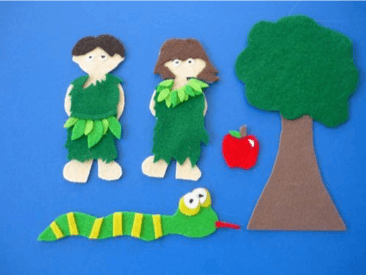Our Sunday school lessons are well-suited for the beginning of the story—the creation of the world, a man, a woman, and a garden. If you grew up in the 90’s like I did, those Sunday school lessons likely involved felt boards with cut-outs of all the major players. The little felt woman grabs the little felt apple, gives it to her felt man, et voila.

Just as palatable for Sunday school classrooms is the end of the story, the New Testament where all of this is headed—the ministry and miracles of Jesus, his death and resurrection, and the extension of the Good News through his disciples.
It’s the bits in the middle that aren’t always easy to digest (by “bits in the middle” I mean most of the Bible, by word count). I can’t recall a Sunday school lesson about the mass killings of Israelite babies, the abuse of Tamar, or Jael driving a stake through Sisera’s unsuspecting head. I’ve searched the internet and can’t seem to find any felt board cutouts of these incidents, either.
Though your Sunday school lessons may have left out those bits in the middle, Worthy does not. In chapters 4–7, we move past the lessons from creation and the fall to explore the role that women play in the sometimes-challenging stories and often-outdated culture of God’s people during the post-Abraham/pre-Christ centuries. In these chapters, Fitzparick and Schumacher attempt to demonstrate the value of women in God’s narrative by exploring the history, law, worship and wisdom of the Old Testament nation of Israel.
A key argument is that in the meta-story of God’s redemptive arc for all of humanity, deliverance, worship and wisdom often come through women. The authors point this out at first in a very literal sense. The Savior (capital “s”) doesn’t ride to earth on a flaming chariot or on a bed of clouds, but he is born just as we all are, by and through a woman. Fitzparick and Schumacher highlight this responsibility when they suggest that Eve “spent her life awaiting the Conquering Son who would reverse the curse” (p. 73), as did generations of women after her.
Again and again, God overcomes the impossible to iterate on this narrative: deliverance will come through a woman giving birth. Just look at the stories of Sarah and Mary, whose inability to have children (through barrenness for the former and virginity for the latter) was undone or superseded by God for his redemptive purposes.
Of course, it’s extremely important to note that “now, since the Promised Son has come, a woman’s identity is no longer contingent upon her giving birth…” and that “…a woman’s call is to expand God’s kingdom through many different vocations” (p. 78). In fact, the authors remind us that, “…the stories and practices we read about in the Bible are not necessarily to be copied but rather a description of the ways things actually were in a broken world.” (p. 97). We cannot take the examples of Sarah and Mary and assume that a woman’s worth comes from her ability to bear children. That’s a misunderstanding of the authors’ argument.
Childbearing aside, women are not just the physical channel by which Israel’s saviors (lowercase “s”) are born. Fitzparick and Schumacher point out that women are often the unsung heroes who make it possible for these men to rise up and become the biblical giants that we know. Take the story of Moses. “The courageous faith of nearly anonymous women” (p. 81) like Siphrah, Puah, Jochebed and Miriam took on great danger and personal risk to ensure his survival and enable his leadership.
Bathsheba, too, persevered through immense personal tragedy to invest in her son and equip him to be a wise ruler. “King Solomon, a man known as Israel’s wisest king, tells us that as a child he learned wisdom from his mother” (p. 124).
Chapters 4–7 have much more to say about the ways in which scripture elevates the role of women through the stories of Israel (I was especially interested in some of their arguments around the role of women in worship), but I think the overarching theme is this: If you thought that they were minor players in the story of the nation of Israel, you were wrong.
Miriam, Sarah, Bathsheba, Jael—these women have compelling stories that help us understanding the worship of God, the faithfulness of God, the wisdom of God and the power of God. And their stories are worth your attention, even if they’re a little too complex to be told on a felt board.
Reflection
1.Let’s talk about context. The culture of Old Testament Israel was one in which women were highly disadvantaged, abused, and discriminated against, even more than our context today in the United States, “…the structure of that society was weighted so heavily in a man’s favor…” (p. 97).
The authors even suggest that the interpretation of God’s word was colored by context: “Let’s notice how the religious elite, the leading men of the day, had twisted this law to fit their chauvinism.” (p.100).
Does this cultural understanding impact our reading of these Old Testament stories? If so, how?
2. Siphrah, Puah, Jochebed: without having read these chapters, would you have recognized those names? I admit that I didn’t give these important characters a second thought before I read their stories. Or, what about the role that Miriam played in inciting the Israelites to worship or Bathsheba in influencing King Solomon?
If so, who taught you those stories and in what context? If not, what does that tell us about the stories that we choose to tell—the biblical narratives that we lean on and elevate as a culture? Do we have a responsibility to go deeper than the felt boards? If so, how?
3. “This better covenant is now open to everyone, both women and men, as all believers, male and female, are now members of the ‘chosen race’ the ‘royal priesthood’ (1 Peter 2:9)” (p. 103).
Starting in Chapter 8, we’ll get to the birth of Jesus, and we can start discussing the role of women in light of this new and better covenant. Without looking ahead, how do you expect the role of women to change (or not) in the biblical narrative moving forward?
